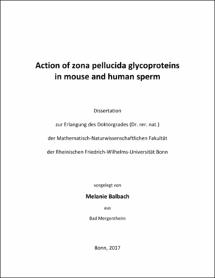Action of zona pellucida glycoproteins in mouse and human sperm

Action of zona pellucida glycoproteins in mouse and human sperm

| dc.contributor.advisor | Wachten, Dagmar | |
| dc.contributor.author | Balbach, Melanie | |
| dc.date.accessioned | 2020-04-24T00:00:27Z | |
| dc.date.available | 2020-04-24T00:00:27Z | |
| dc.date.issued | 22.08.2017 | |
| dc.identifier.uri | https://hdl.handle.net/20.500.11811/7210 | |
| dc.description.abstract | For fertilization, sperm have to penetrate the oocyte’s vestment, the zona pellucida (ZP). In mouse and human, the ZP consists of three or four different ZP glycoproteins, respectively. Binding of sperm to ZP glycoproteins evokes sperm hyperactivation and acrosome reaction, which enables sperm to penetrate the ZP. However, the ZP-induced signaling pathways underlying these behavioral responses are ill-defined. Therefore, in my thesis I investigated ZP signaling in mouse and human sperm. In both species, mixing with ZP glycoproteins evoked rapid changes in intracellular pH (pHi) and intracellular Ca2+ concentration ([Ca2+]i). I was able to confirm that the sperm-specific Ca2+ channel CatSper mediates the ZP-evoked Ca2+ influx in mouse and human sperm. However, my experiments demonstrate that the molecular mechanism underlying CatSper activation by ZPs are distinctively different in mouse and human. In human sperm, CatSper activation does not require pHi alkalization. Here, human ZP glycoproteins directly activate CatSper. However, in mouse sperm, the alkalization is essential for the ZP-evoked Ca2+ influx via CatSper. Moreover, my experiments reveal that ZP-induced alkalization is mediated by different proteins in mouse and human. In mouse sperm, ZP-evoked alkalization requires extracellular Na+; however, the prominent candidate to control ZP-evoked alkalization, the sperm-specific Na+/H+ exchanger, is not fulfilling this function. My results rather demonstrate that another protein of the Na+/H+ exchanger family, the sodium-proton antiporter 1 (NHA1), controls ZP-evoked alkalization. In NHA1 KO mice, the ZP-evoked increase in pHi and [Ca2+]i was strongly attenuated. The mechanism underlying NHA1 activation remains, however, elusive. ZP-evoked alkalization was suppressed under depolarized membrane potentials, indicating that a polarized membrane potential is crucial for NHA1 activation. In human sperm, a polarized membrane potential was also required for ZP-evoked pHi signaling, however, ZP-evoked alkalization is, in contrast to mouse sperm, not mediated by a Na+/H+ exchange. My work provides important new insights into the molecular mechanism underlying the action of ZP glycoproteins in mouse and human sperm and reveals fundamental differences between the two species, questioning the mouse as appropriate model system to study fertilization in human. | en |
| dc.language.iso | eng | |
| dc.relation.ispartofseries | caesar ; 00027 | |
| dc.rights | In Copyright | |
| dc.rights.uri | http://rightsstatements.org/vocab/InC/1.0/ | |
| dc.subject.ddc | 570 Biowissenschaften, Biologie | |
| dc.subject.ddc | 610 Medizin, Gesundheit | |
| dc.title | Action of zona pellucida glycoproteins in mouse and human sperm | |
| dc.type | Dissertation oder Habilitation | |
| dc.publisher.name | Universitäts- und Landesbibliothek Bonn | |
| dc.publisher.location | Bonn | |
| dc.rights.accessRights | openAccess | |
| dc.identifier.urn | https://nbn-resolving.org/urn:nbn:de:hbz:5n-47868 | |
| ulbbn.pubtype | Erstveröffentlichung | |
| ulbbnediss.affiliation.name | Rheinische Friedrich-Wilhelms-Universität Bonn | |
| ulbbnediss.affiliation.location | Bonn | |
| ulbbnediss.thesis.level | Dissertation | |
| ulbbnediss.dissID | 4786 | |
| ulbbnediss.date.accepted | 19.06.2017 | |
| ulbbnediss.institute | Mathematisch-Naturwissenschaftliche Fakultät : Fachgruppe Molekulare Biomedizin / Life & Medical Sciences-Institut (LIMES) | |
| ulbbnediss.fakultaet | Mathematisch-Naturwissenschaftliche Fakultät | |
| dc.contributor.coReferee | Thiele, Christoph |
Files in this item
This item appears in the following Collection(s)
-
E-Dissertationen (4306)




